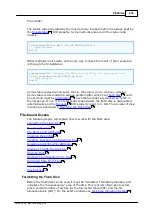
438
Platforms
©2000-2008 Tibbo Technology Inc.
END BOOT sector -- keeps the same data as the BOOT sector, but is located
past the data area.
FRT area
Each file record occupies 64 bytes. Therefore, each sector of the FRT area can fit 4
file records. Therefore, if you specify during formatting that you would like to have
15 different files, the
method will round this up to 16 files. This will
require 4 sectors to fit. Actual amount of allocated sectors is always double that.
This is done for sector
, which the fd. object takes care of internally.
Also, the number of allocated sectors is never less than 8, again, for sector leveling
reasons.
The maximum number of files stored by the .fd object is 64. Thefore, the
maximum size of the FRT area is (64/4)*2= 32 sectors. Hence, the size of the FRT
area is always between 8 and 32 sectors depending on the maximum number of
files you need to store on the disk.
FAT area
Each FAT sector consists of 128 FAT entries, 2 bytes per entry. Therefore, each FAT
sector can fit the allocation data for 128 sectors from the data area of the disk. To
improve sector leveling, the number of sectors allocated for the FAT area is, again,
doubled against what's necessary. So, for every 128 sectors in the data area of the
disk there are 2 sectors in the FAT area. At least 16 sectors are always allocated to
FAT.
For example, supposing that the data area has 1100 sectors. Therefore,
1100/128= 9 FAT sectors are needed. The fd. object will allocate double this
required minimum, so 18 FAT sectors will be prepared. Let's suppose now that we
only have 500 data sectors. This requires 4 FAT sectors, 8 after we double this
amount. This is less than the minimal 16 FAT sectors that are always provided, so
the fd. object will still allocate 16 sectors.
Allocation and capacity calculation example
The fd.format method takes, as an input parameter, the total number of sectors
467
453
















































